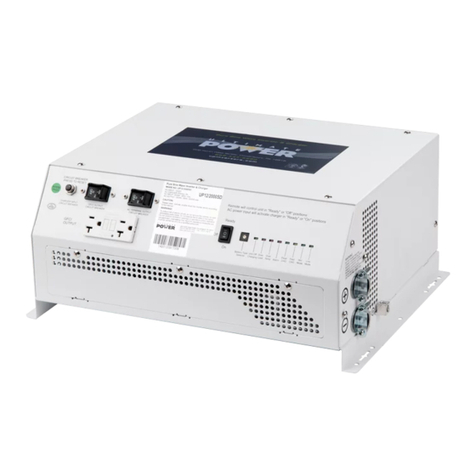
Ultimate Power www.upinverters.com
Table of Contents
1 Important Safety Information............................................................................................................................................... - 2 -
1.1 General Safety Precautions................................................................................................................................................- 2 -
1.2 Precautions When Working with Batteries........................................................................................................................- 3 -
2 Introduction...........................................................................................................................................................................- 3 -
2.1 General Information...........................................................................................................................................................- 3 -
2.2 Mechanical Drawing..........................................................................................................................................................- 4 -
2.2.1 DC SIDE......................................................................................................................................................................... - 4 -
2.2.2 UP12/600LP-C,UP12/1000LP-C AC SIDE................................................................................................................. - 4 -
2.2.3 UP12/600LP-CG,UP12/1000LP-CG AC SIDE..............................................................................................................- 5 -
2.2.4 UP12/1500LP-CG DC SIDE.......................................................................................................................................... - 5 -
2.2.5 UP12/1500LP-CG AC SIDE...........................................................................................................................................- 5 -
2.3 Features.............................................................................................................................................................................. - 6 -
2.4 Electrical Performance.....................................................................................................................................................- 7 -
2.4.1 Invert....................................................................................................................................................................... - 7 -
2.4.2 AC Charger..............................................................................................................................................................- 7 -
2.4.3 Transfer................................................................................................................................................................. - 10 -
2.4.4 Remote Operation................................................................................................................................................. - 10 -
2.4.5 Protections.............................................................................................................................................................- 11 -
2.4.6 LED Indicator....................................................................................................................................................... - 12 -
2.4.7 Audible Alarm.......................................................................................................................................................- 13 -
2.4.8 FAN Operation......................................................................................................................................................- 13 -
2.4.9 DIP Switches.........................................................................................................................................................- 13 -
2.4.10 Auto Generator Start........................................................................................................................................... - 15 -
2.4.11 Battery Temperature Sensing..............................................................................................................................- 15 -
2.4.12 Other Features.....................................................................................................................................................- 16 -
3 Installation...........................................................................................................................................................................- 16 -
3.1 Location....................................................................................................................................................................- 16 -
3.2 DC Wiring Recommendation...................................................................................................................................- 16 -
3.3 AC Wiring Recommendations................................................................................................................................. - 18 -
3.4 Grounding................................................................................................................................................................ - 18 -
3.5 Mounting Flange......................................................................................................................................................- 19 -
4 Maintenance & Troubleshooting........................................................................................................................................ - 21 -
Limited Warranty Plan........................................................................................................................................................... - 23 -
Appendix 1 : LP Series Inverter/Charger Spec Sheet............................................................................................................- 24 -





























